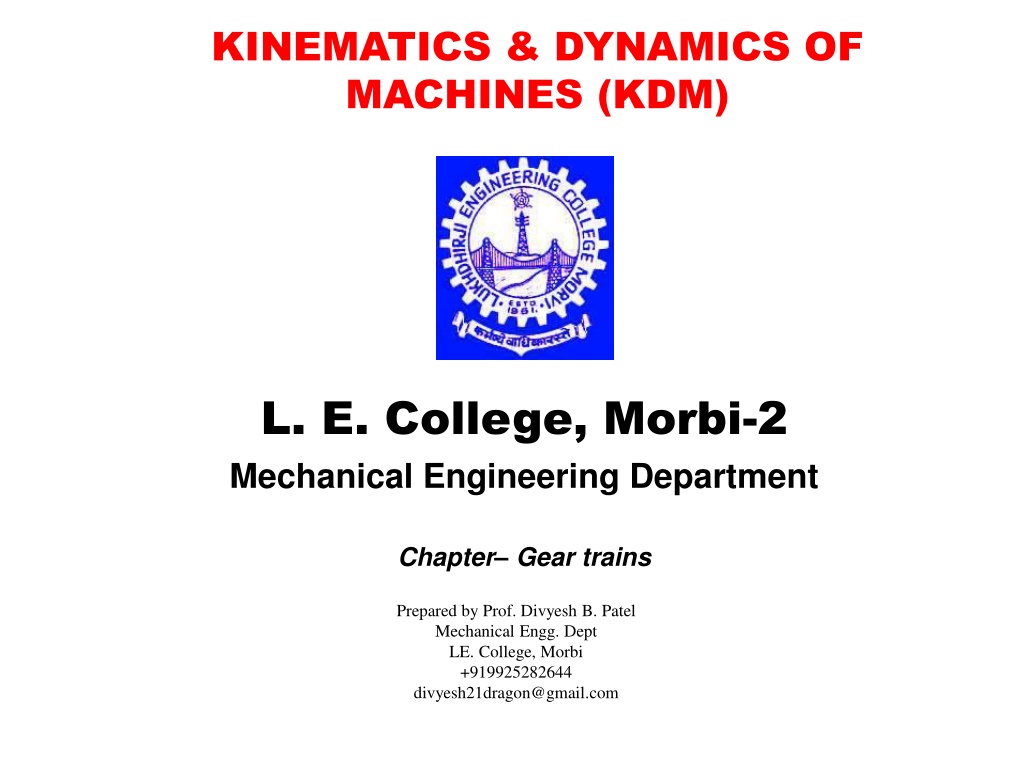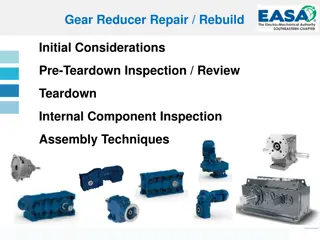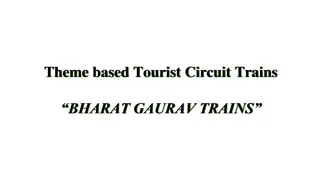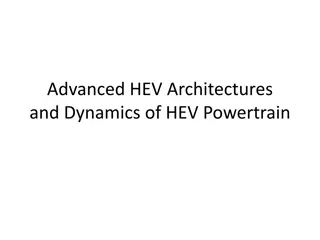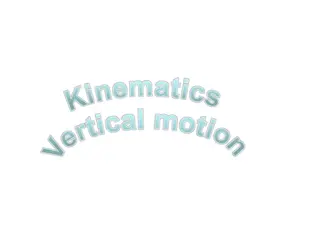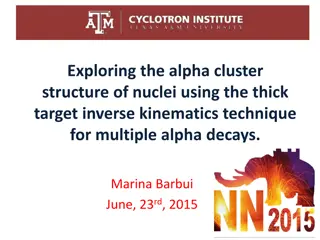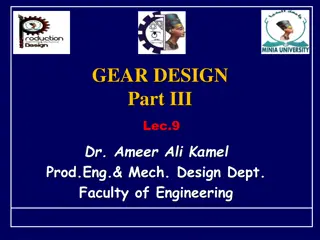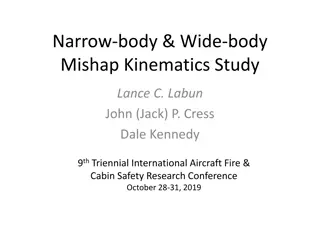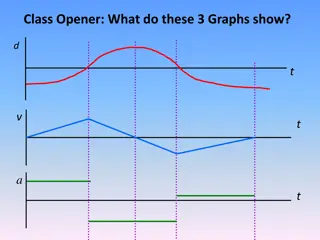Gear Trains: Kinematics and Dynamics Explained
Gear trains in machines play a vital role in transmitting power between shafts. This chapter prepared by Prof. Divyesh B. Patel covers the basics of gear trains, including types like simple, compound, reverted, and epicyclic. It explains the concept of gear ratios, teeth numbers, and the arrangement of gears in different types of gear trains. Understanding gear trains is crucial for mechanical engineers to design efficient and reliable machine systems.
Uploaded on Sep 18, 2024 | 0 Views
Download Presentation

Please find below an Image/Link to download the presentation.
The content on the website is provided AS IS for your information and personal use only. It may not be sold, licensed, or shared on other websites without obtaining consent from the author.If you encounter any issues during the download, it is possible that the publisher has removed the file from their server.
You are allowed to download the files provided on this website for personal or commercial use, subject to the condition that they are used lawfully. All files are the property of their respective owners.
The content on the website is provided AS IS for your information and personal use only. It may not be sold, licensed, or shared on other websites without obtaining consent from the author.
E N D
Presentation Transcript
KINEMATICS & DYNAMICS OF MACHINES (KDM) L. E. College, Morbi-2 Mechanical Engineering Department Chapter Gear trains Prepared by Prof. Divyesh B. Patel Mechanical Engg. Dept LE. College, Morbi +919925282644 divyesh21dragon@gmail.com
Prepared by Prof. D.B.Patel Mechanical Engg. Dept LE. College, Morbi Gear Trains 1. Introduction Sometimes, two or more gears are made to mesh with each other to transmit power from one shaft to another. Such a combination is called gear train or train of toothed wheels. Prof. Divyesh B Patel 2
Prepared by Prof. D.B.Patel Mechanical Engg. Dept LE. College, Morbi Gear Trains 2. Types of Gear Trains a) Simple gear train, b) Compound gear train, the axes of the shafts over which the gears are mounted are fixed relative to each other c) Reverted gear train, the axes of the shafts on which the gears are mounted may move relative to a fixed axis d) Epicyclic gear train. Prof. Divyesh B Patel 3
Prepared by Prof. D.B.Patel Mechanical Engg. Dept LE. College, Morbi Gear Trains 2.1. Simple Gear Train 1 2 Driver Driven or Follower N1 = Speed of gear 1(or driver) in r.p.m., N2 = Speed of gear 2 (or driven or follower) in r.p.m., T1 = Number of teeth on gear 1, and T2 = Number of teeth on gear 2. 4
Prepared by Prof. D.B.Patel Mechanical Engg. Dept LE. College, Morbi Gear Trains 2.1. Simple Gear Train 1 3 4 2 Driver Driven or Follower Intermediate gears N1/ N3 = T3 /T1 ..(i) N3/ N4 = T4 /T3 ..(ii) Multiplying the equations (i) ,(ii) and (iii). N4/ N2 = T2 /T4 ..(iii) N1 / N3 N3 / N4 N4 / N2 = T3 /T1 T4 /T3 T2 /T4 N1 / N2 = T2 / T1 From above, we see that the speed ratio and the train value, in a simple train of gears, is independent of the size and number of intermediate gears. These intermediate gears are called idle gears, 5
Prepared by Prof. D.B.Patel Mechanical Engg. Dept LE. College, Morbi Gear Trains 4 2.2. Compound Gear Train 3 2 1 Driven or Follower C Driver B Compound gears A N1/ N2 = T2 /T1 ..(i) N3/ N4 = T4 /T3 ..(ii) Multiplying the equations (i) and (ii). N1 / N2 N3 / N4 = T2 /T1 T4 /T3 N1 / N4 = T2 /T1 T4 /T3 Since gears 2 and 3 are mounted on one shaft B, therefore N2 = N3. 6
Prepared by Prof. D.B.Patel Mechanical Engg. Dept LE. College, Morbi Gear Trains 2.3. Reverted Gear Train 4 Driver C 1 Driven or Follower A 3 2 B N1 = Speed of gear 1(or driver) in r.p.m., T1 = Number of teeth on gear 1, and r1 = Pitch circle radius of gear 1. T2, T3, T4 = Number of teeth on respective gears, r2 ,r3 ,r4 = Pitch circle radii of respective gears, and N2, N3, N4 = Speed of respective gears in r.p.m. 7
Prepared by Prof. D.B.Patel Mechanical Engg. Dept LE. College, Morbi Gear Trains 2.3. Reverted Gear Train 4 Driver C 1 Driven or Follower A 3 2 B Since the distance between the centers of the shafts of gears 1 and 2 as well as gears 3 and 4 is same, therefore r1 + r2= r3 + r4 Also, the circular pitch or module of all the gears is assumed to be same, therefore number of teeth on each gear is directly proportional to its circumference or radius. T1 + T2= T3 + T4 8
Prepared by Prof. D.B.Patel Mechanical Engg. Dept LE. College, Morbi Gear Trains 2.3. Reverted Gear Train We know that circular pitch, PC = ( 2 r)/T = m or r = (m T)/2 , where m is the module. r1 = (m T1)/2 ; r2 = (m T2)/2 ; r3 = (m T3)/2 ; r4 =(m T4)/2 ; (m T1)/2 + (m T2)/2 = (m T3)/2 + (m T4)/2 ; T1 + T2= T3 + T4 N1 / N4 = T1 / T2 T3 / T4 9
Example-1 The speed ratio of the reverted gear train, as shown in Fig., is to be 12. The module pitch of gears A and B is 3.125 mm and of gears C and D is 2.5 mm. Calculate the suitable numbers of teeth for the gears. No gear is to have less than 24 teeth. Prof. Divyesh B Patel 10
Thank you Prof. Divyesh B Patel 11
